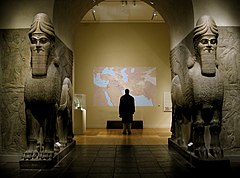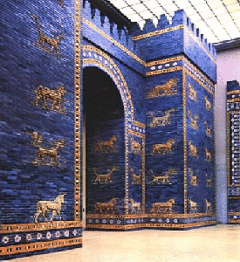
Back عمارة بلاد ما بين النهرين Arabic Mesopotamiya memarlığı Azerbaijani Arquitectura de Mesopotàmia Catalan Architektur Mesopotamiens German Arkitekturo de Mezopotamio Esperanto Arquitectura de Mesopotamia Spanish معماری میانرودان Persian Architettura mesopotamica Italian 메소포타미아 건축 Korean Arhitektura Mezopotamije Slovenian
Top: Lamassu from The Gate of Nimrud, Nineveh, approximately 1350 BC; Centre: The Ziggurat of Ur, approximately 21st century BC; Bottom: Reconstruction of the Ishtar Gate of Babylon, approximately 575 BC in the Pergamon Museum | |
| Years active | 10th millennium-6th century BC |
|---|---|
The architecture of Mesopotamia is ancient architecture of the region of the Tigris–Euphrates river system (also known as Mesopotamia), encompassing several distinct cultures and spanning a period from the 10th millennium BC (when the first permanent structures were built) to the 6th century BC. Among the Mesopotamian architectural accomplishments are the development of urban planning, the courtyard house, and ziggurats. Scribes had the role of architects in drafting and managing construction for the government, nobility, or royalty.
The study of ancient Mesopotamian architecture is based on available archaeological evidence, pictorial representation of buildings, and texts on building practices. According to Archibald Sayce, the primitive pictographs of the Uruk period era suggest that "Stone was scarce, but was already cut into blocks and seals. Brick was the ordinary building material, and with it cities, forts, temples, and houses were constructed. The city was provided with towers and stood on an artificial platform; the house also had a tower-like appearance. It was provided with a door which turned on a hinge, and could be opened with a sort of key; the city gate was on a larger scale, and seemed to have been double. ... Demons were feared who had wings like a bird, and the foundation stones – or rather bricks – of a house were consecrated by certain objects that were deposited under them."[1]
Scholarly literature usually concentrates on the architecture of temples, palaces, city walls and gates, and other monumental buildings, but occasionally one finds works on residential architecture as well.[2] Archaeological surface surveys also allowed for the study of urban form in early Mesopotamian cities.
- ^ Sayce, Rev. A. H., Professor of Assyriology, Oxford, "The Archaeology of the Cuneiform Inscriptions", Second Edition-revised, 1908, Society for Promoting Christian Knowledge, London, Brighton, New York; at pages 98–100 Not in copyright
- ^ Dunham, Sally (2005). "Ancient Near Eastern architecture". In Daniel Snell (ed.). A Companion to the Ancient Near East. Oxford: Blackwell. pp. 266–280. ISBN 978-0-631-23293-3.


